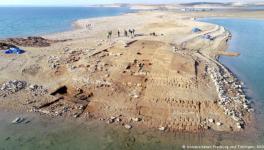DNA Analysis Reveals Surprising Facts About the Tarim Basin Mummies of China

Image: Tarim Basin Mummy. Image source: Wikipedia.
Tarim Basin in China has hundreds of naturally preserved mummies that have generated curiosity among archaeologists. European explorers discovered these mummies about a century ago. Some researchers believe that these remains from the Bronze Age were migrants from the west, thousands of kilometres away. The migrants were thought to bring farming practices to the Chinese terrain.
However, a new analysis of the DNA of the mummies has revealed many new facts. The new study, published in Nature on October 27, suggests that the mummies are the remains of some indigenous people who probably adopted agricultural methods from their neighbouring groups.
The latest Nature paper traced the ancestry of these archaic people in China and found that they were related to the stone age hunter-gatherers that inhabited Asia around 9000 years ago. The study findings also suggested that despite appearing to be genetically isolated, the mummies belong to people who raised livestock and grew grains similar to other groups.
The researchers involved in the study are from different backgrounds and are based in China, South Korea, Germany and the US.
Christina Wariner, one of the co-authors of the study and a molecular archaeologist at Harvard University, Boston, commented on the findings saying, “The study hints at the diverse ways in which populations move and don’t move, and how ideas can spread with, but also through, populations.”
The study is also important from another perspective. It found that despite being genetically isolated, the group of people in the Tarim Basin could acquire the knowledge of farming and growing livestock, having adopted it from neighbouring groups. This is indicative of the fact that cultural exchange may not always accompany genetic variations.
Further commenting on the findings, Michael Frachetti, an archaeologist at Washington University, US, said, “The finding demonstrates that cultural exchange doesn’t always go hand in hand with genetic ties. Just because those people are trading doesn’t necessarily mean that they are marrying one another or having children.”
The Tarim Basin mummies were found in cemeteries of the Xiaohe culture of China. The cemeteries were found scattered across the Taklamakan desert in China’s Xinjiang region. The bodies excavated here were buried in boat-shaped coffins and were wrapped in cattle hide.
The mummies were preserved due to the natural environmental conditions of the area— hot, arid and salty. From hair to clothing, everything was found perfectly intact. The mummies were buried here over 2000 years ago, which is a significant period in the history of Xinjiang. This period marks the transition of communities from hunter-gatherers to farmers.
Notably, some of the mummies in later periods were buried with woollen fabrics and clothes similar to those in the west. The graves also contained grains like millet and wheat, along with animal bones and dairy products. This is indicative of agricultural and pastoral techniques found in other regions of Eurasia. This led researchers to initially hypothesise that the mummies are of migrants from the west who travelled through Siberia, Central Asia, and Afghanistan.
But the latest Nature paper found no support in favour of the earlier hypothesis. The researchers sequenced genomes of 13 individuals who inhabited the region some 4100 to 3700 years ago and five other mummies from hundreds of kilometres away from the Tarim Basin. These people lived between 5000 to 4800 years ago.
They then compared the genetic information of these people with genomes that were sequenced previously, comprising 100 ancient groups of people and 200 people from the modern world.
Their analysis found that the five mummies away from the Tarim Basin had genetic similarities with Bronze Age migrants from the Altai Mountains that lived 5000 years ago. However, the 13 mummies from the Tarim Basin were different from this ancestry. These people shared ancestry with the hunter-gatherers of southern Siberia some 9000 years ago.
The researchers also analysed dental plaques of the teethe of some of the older mummies. The dental analysis revealed that the people may have consumed dairy proteins from sheep, goats and cattle. This suggested that the earliest settlers of the region were also drinking milk.
Get the latest reports & analysis with people's perspective on Protests, movements & deep analytical videos, discussions of the current affairs in your Telegram app. Subscribe to NewsClick's Telegram channel & get Real-Time updates on stories, as they get published on our website.
















